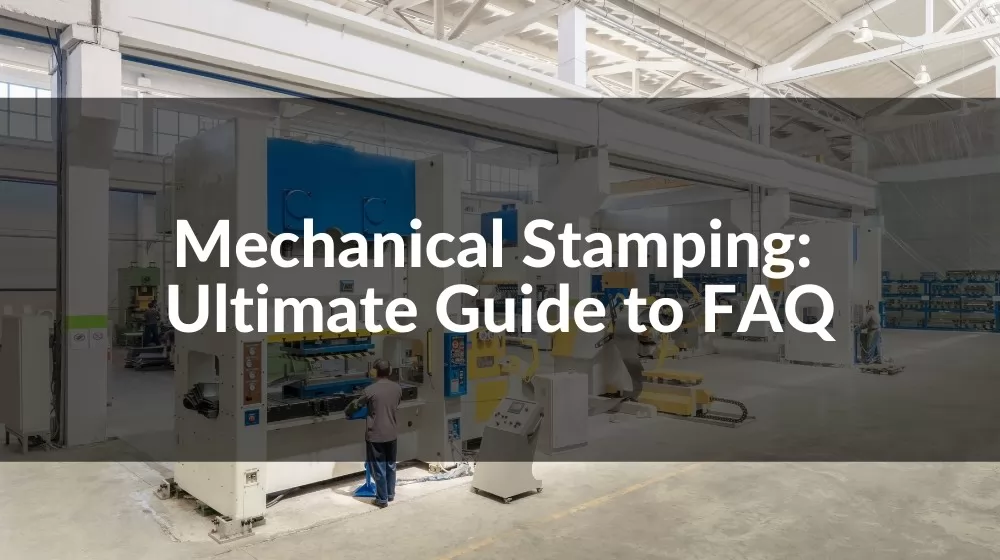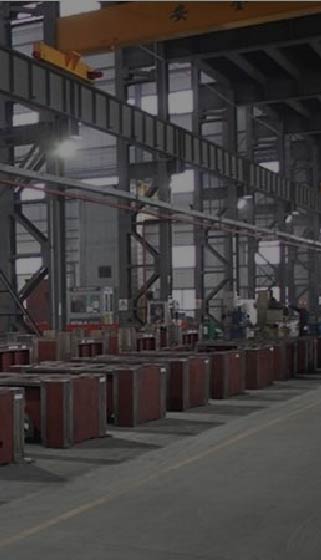








The market for mechanical stamping is still very promising, and investing in mechanical stamping is a very worthy option to consider. This guide will provide detailed answers to the knowledge and questions about Mechanical stamping and will hopefully help you in your choice.
What are the common stamping materials used for Mechanical stamping?
What are the factors to consider when purchasing Mechanical stamping?
What are the main technical specifications of Mechanical stamping?
What is the best maintenance method for Mechanical stamping?
What are the key safety measures to be observed when operating Mechanical stamping?
Mechanical stamping is a metal stamping and forming machine that uses preformed dies and pressure to form sheet metal blanks into products and parts. The manufacturer uses an automatic or manual feeder to insert the sheet metal into the stamping press between the tool and the die surface. The press descends onto the sheet metal and uses compressive forces to press the material into the die to form the desired shape.
Metal can be shaped or cut precisely to your specifications. The process involves forming, stretching, trimming, punching and/or perforating the metal with a die. Typically, the process is available in sheet metal and coil form.
The press consists of a pad and a plunger. The stamping process works by forming the metal between the two halves of the stamping tool. The top part is attached to the slide of the press, while the bottom part is attached to a fixed pad (or bed). Some large presses also have a die pad integrated into the pad plate that helps apply the crimping force
Mechanical stamping press is generally distinguished by the body structure type and application characteristics.
According to the body structure type: there are open and closed two types.
Open type presses are mostly vertical. The body is C-shaped, the front, left and right side open, simple structure, easy to operate, The body is C-shaped, the front, left and right side open, simple structure, easy to operate, the body can be tilted to a certain angle, so that the workpiece slides down into the hopper, easy to achieve automation, But the open body rigidity is poor, affecting the accuracy of the parts and die life, only for 40 ~ 4000 kN of small and medium-sized presses.
The body is H-shaped, the front and rear of the body open, good rigidity, high precision, the size of the table is larger, suitable for pressing large parts, The body is H-shaped, the front and rear of the body open, good rigidity, high precision, the size of the table is larger, suitable for pressing large parts, nominal working force of 1600 ~ 60000 kN. cold extrusion, hot die forging and double-action deep drawing and other heavy presses use closed body.
According to the application characteristics: there are double-action deep drawing press, multi-station automatic press, rotary head press, hot die forging press and cold extrusion press.
Mechanical stamping offers high production speeds and allows for mass production. On Mechanical stamping, only a few standard parameters can be set, so the machine is not as flexible or versatile as a hydraulic press. Mechanical stamping usually requires an operator to manage the operations associated with the strikes. Therefore, it is necessary to equip such machines with suitable safety devices, such as foot switches, grills, etc.
MachineMechanical stamping are usually high precision machines and can guarantee repeated strikes over time. On the other hand, they run only on a given course. Therefore, it is important to check that the opening distances are appropriate for the part size before and after manufacturing.
MachineMechanical stamping makes forming metal materials easier and more efficient. Understanding the different types and how they work will allow you to choose the one that best suits your business.
Mechanical stamping machines can stamp and form a variety of metals, including ferrous and non-ferrous metals. Typically the type of metal chosen for a metal stamping part depends greatly on its intended application as well as the size, shape and design of the product.
Ferrous metals containing iron are usually magnetic and tend to be strong and durable. Steel is a well known ferrous metal with a wide range of uses. Ferrous metals are valued for their high strength, but their iron content makes them more susceptible to rust and corrosion than non-ferrous metals. Carbon steel is the most commonly used ferrous metal in metal stamping applications because of its extremely high tensile strength.
Non-ferrous metals and alloys do not include iron and are therefore not magnetic. Non-ferrous metals are very popular in a variety of stamping products because of their high ductility and wide range of useful properties. The most common non-ferrous metals used in stamping applications include aluminum, tin, copper, brass, bronze, gold and silver. Aluminum is particularly popular in stamped parts and products due to its low cost, lightweight strength and corrosion resistance.
When selecting the right material for your metal stamping application, it is also important to consider the material composition of the tooling you will be using. While most dies consist of tool or hardened steel, different workpiece materials or processes may require alternative die materials, such as aluminum or mild steel.
Many Chinese Mechanical stamping manufacturers combine American, European and domestic technologies with Chinese manufacturing advantages.
This alone gives Chinese companies the upper hand over all of their global competitors. As a result, most Chinese Mechanical stamping is cost competitive with American and European made machines.
You will find that most European and American companies have OEM partners in China. Nevertheless, using this business model, you will pay more for Mechanical stamping.
In short, it is cost effective to source Mechanical stamping from China. Always strive for the best deal.
Before you start browsing and selecting a Mechanical stamping machine, write down a general list of the jobs you regularly perform. Whether it's drop stock, stamping, punching, bending, deep drawing, metal forming or molding, know how you will use your new press.
This will tell you which processes you need the machine Mechanical stamping to perform.
Modern presses for mechanical stamping have a wide range of tonnage and many features. Many make it easy to control pressure and plunger speed. These presses are highly customizable and can easily handle a variety of jobs. Use a full-featured press that can handle many types of jobs from the master list of processes you often need to complete.
The latest mechanical presses can handle more complex jobs faster and more efficiently than previous presses. They are equipped with programmable electronic control panels. This means you can customize your press features to individual jobs and their specifications. You get a consistently high level of output excellence at a faster rate.
Most machine shops need to deliver high-end results for their customers. That's why it's critical to choose a machine press that offers precision and accuracy for every job. Choose a model with an adjustable power function and lateral movement slide control. This can prevent problems with unbalanced loads.
Choose technology that allows your operators to take full advantage of the press, using its design and production techniques creatively. If you need low tonnage, use a larger press. Smaller bed presses can handle high tonnage and high quality finishes, using side action, under action and multi-action.
Modern machineMechanical stamping saves space and minimizes maintenance costs. They take up less than half the space of machineMechanical stamping. This means you can make efficient use of store space. Ensure that spare parts for the press you are working on are easy to find, thus limiting potential downtime.
It is important to know how the starting tonnage is calculated in order to choose the most suitable mechanical stamping press.
The calculation formula is as follows.
P= p/q= (64-73) F/q where P---- screw press tonnage (KN)
p - the deformation force required for die forging (KN)
F - forging together with the projected area of the flying edge (cm 2)
(64 to 73) - the coefficient is taken as 73 for complex forgings and 64 for simple parts.
q - is a deformation coefficient, which can be divided by stroke and deformation work in spiral press die forging.
Forgings require a larger deformation stroke, deformation and deformation work in die forging, q = 0.9 to 1.1.
When forgings need smaller deformation stroke and deformation work of die forging q=1.3.
When the forgings need only a small deformation stroke, but need a large deformation force for fine pressing q=1.6.
P=(17.5~28)KF total (KN) where the total projected area of forging together with flying edge (㎝2)
K - steel grade coefficient, refer to the third unit of the equipment tonnage calculation chapter; ((17.5-28) - coefficient 28 is used for difficult deformation (such as extrusion deformation, deformation with flying edges, etc.) and high productivity, and vice versa. The above formula applies to the calculation of the required equipment tonnage hammering 2-3 times.
If a single stamping is required, it should be doubled as calculated.
Mechanical stamping machines should be maintained in a standard way during daily use. There is no doubt that normal and reasonable maintenance can greatly save production costs for later maintenance and bring greater cost benefits.
Before each shift, operate the brake shaft of the manipulator with full lubricating oil at each point, and lubricate the clutch part with oil pressure once a day. Clean the machine before stopping each shift.
Inspect all aspects of the mechanical press. Check fasteners and make up missing external parts; check the clutch, springs and belts; check the lubrication device of the machine; check the damage and aging of the circuit and the normalcy of the motor and solenoid; check the accuracy and wear of the crankshaft guide; check the brake, clutch, slider, closing block and closing ring; check the electrical control part; check and adjust the body table connecting bolts.
According to the different types of presses and processing requirements, develop targeted and practical safety operating procedures, and conduct the necessary job training and safety education. Using units and operators must strictly comply with the design and manufacturing units, provide safety instructions and operating procedures, and use and maintain them correctly.
Pay attention to safety during maintenance to ensure that the locking and opening process is performed correctly to ensure the safety of maintenance personnel and that the sleeve is placed at the bottom of the stroke before performing maintenance work on the brake. If this is done, the sleeve does not need to be locked.
Shop floor environmental controls. A clean press allows the operator or maintenance personnel to identify problems as soon as they occur. For example, if the press is clean, it is easy to identify the location of oil leaks, air leaks, breaks, etc.
Make sure the mechanical press is in a balanced position. A precisely balanced press will work better, so it is best to check it once a year. Pneumatic systems that operate pneumatic braking and balancing systems need to be checked for air leaks, as improper air pressure can affect the performance of the braking and balancing systems and they control the stopping time of the press, which can put the operator and the equipment at risk if there is a problem. In addition, all pneumatic systems have regulators, lubricators and water reservoirs. Water that accumulates in the gas lines should be removed daily.
Replace lubricants and screens regularly. Improper maintenance of the press lubrication system is also a major cause of press downtime. For a variety of reasons, many press operators operate screen-equipped circulating oil systems without changing screens regularly. Be sure to change the screen at the same time as the oil change and generally change it frequently.
Precautions to be observed before and after starting the Mechanical stamping machine
Check the safety conditions around, in front of, behind, and above and below the machine before starting.
Check whether the air, oil and electric circuits are normal.
Turn on the power to check whether the air supply, oil supply and hydraulic overload protection are normal, and check whether the pressure and electrical indicators of each pressure gauge are normal.
Start, while observing the start electrical status and machine tool mechanical status.
First place the machine in the micro position pointing point to start rotation, while observing whether the state of the machine is normal such as: transmission, slider, balance cylinder, oil supply, etc.
Machine start single, continuous action, check the mechanical transmission, sound, current is normal.
Commissioning, test the performance of each machine such as: adjust the closing height, cam control angle, flywheel brake, air cushion, precision, move the table, manual unloading, etc.
Continuous machine observation such as: whether the alarm, each drive and guide temperature change, air pressure, sound, oil supply, oil circuit, etc.
With the continuous development of stamping technology, the momentum of Mechanical stamping can be improved. High stamping accuracy, good surface quality and long die life.
The mechanical precision automatic presses manufactured by JDM have the following features.
The machine body is welded with high quality steel plate, which eliminates tension and improves the stability of machine accuracy.
To ensure the smooth operation of the machine, a symmetrical two-piece slide design with balancer is adopted.
The accuracy of mold adjustment can reach 0.1mm, which is safe, reliable and convenient.
The crank, gear and connecting rod are oxidation hardened and milled, which have super comprehensive mechanical properties and durable functions.
Reasonable structure design, easy for automatic production and assembly line production.
Adopt reliable high-strength clutch/brake, double solenoid valve and overload protection device to ensure safe production in all aspects.
Adopt high quality alloy steel, double crank, wide working center and connecting rod structure. Optimized design is suitable for pressing large size, large impact load dies and eccentric dies.
Adopt closed-loop circuit, compatible with any automatic equipment.
After purchasing our mechanical presses, we will provide you with long-term service. We will be happy to provide you with the necessary assistance during use. The maintenance effort during the use of the machine Mechanical stamping can be greatly reduced by routine maintenance and inspection. If problems arise, we will do our best to help you get back to production in no time. With our experienced technical team, we can provide you with sound advice on Mechanical stamping.
Read more:






